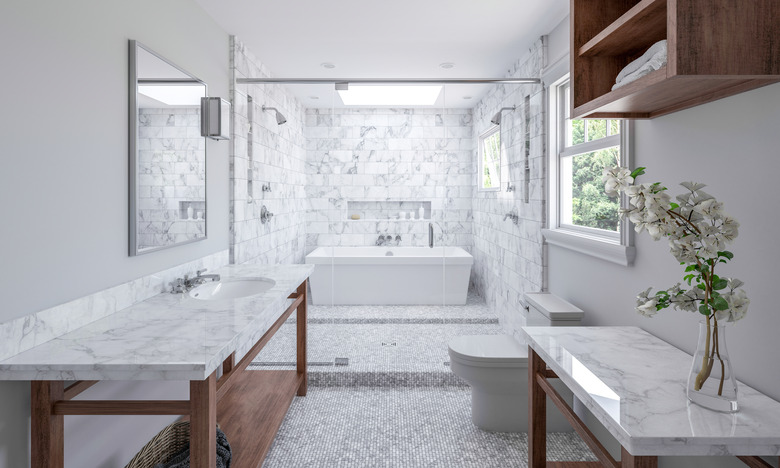How To Unclog Toilet Jets
We may receive a commission on purchases made from links.
Face it — no one likes cleaning inside the toilet or having anything more to do with it than necessary. If you've noticed, however, that the flushing action is slower and less powerful than it used to be, it could be that you simply need to unclog your toilet jets. It's an easy job that you can handle even if you normally shy away from DIY projects. Before you get started, you'll just need to know what a toilet jet is.
What Are Toilet Jets?
What Are Toilet Jets?
Also referred to as rim jets, rim holes, and siphon holes, toilet jets are small openings under the rim of the bowl. When you flush, water pours out of these holes and swirls in a circular motion around the bowl to help clean it and to help with the effectiveness of the flushing action.
Sometimes, however — usually when you have hard water — toilet jets and the siphon jet hole at the bottom of the toilet get blocked with mineral deposits and need to be unclogged.
Test Before Cleaning
Test Before Cleaning
If you have soft water in your home, perform this test to rule out a cause other than calcium buildup. Fill a 5-gallon bucket with water and begin pouring it into the toilet bowl, slowly at first and then quickly. This will initiate flushing action in the toilet that doesn't involve the siphoning system. A slow flushing action using this method indicates that the problem isn't the toilet jets. If the flush is normal, proceed with cleaning.
Things Needed
-
Paper towels or rag
-
White vinegar, 1 gallon
-
Your toilet's product manual or printout of manufacturer's
online diagram of tank design -
Allen wrench, 3/16 inch
How to Clean Toilet Jets
Step 1: Prepare the Inside of the Toilet
The toilet must be drained and dry inside so the vinegar used isn't diluted by any amount of water, and the jet holes must be blocked so the holes can be soaked.
- Turn off the toilet's water supply at the
shutoff valve located on the wall. - Flush the toilet and hold down the handle to
clear out all the water. - Remove the lid and set it aside.
- Wearing gloves, use a paper towels or a rag
to dry excess water in the tank, bowl, and rim area. - Using a hand mirror, look under the rim to
see how the jet holes are positioned. - Cover all the holes with duct tape, which
will contain the vinegar you will pour so the holes can soak in it.
Step 2: Add the Vinegar
Using vinegar as a soaking agent on mineral buildup dissolves the minerals. You'll need to soak and clean not just the jet holes but the siphon hole at the bottom of the bowl.
- Referring to the manufacturer's diagram,
identify where the overflow tube is located in the tank. - Pour vinegar into the overflow tube until the
bowl is holding an amount of vinegar equal to the water it held before
draining. This poured vinegar will fill the siphon hole and will also flow
through the rim, held in by the duct tape so the jet holes can soak. - Allow the vinegar to work for at least an hour.
If the blockages are severe, you can let the toilet soak overnight.
Step 3: Clean It Up
It's important to make sure all of the buildup has been dissolved, dislodged, and washed away in order to have a smoother, faster-flushing toilet.
- Remove the duct tape so the vinegar can run out.
- Insert an Allen wrench into all the jet holes
and rotate it to make sure all buildup is gone and they're unblocked. - Using a toilet brush, scrub around the jet holes
to clean any remaining deposit. - With your gloved hand, feel inside the siphon
hole with a finger to see whether there is remaining buildup. - Using a toilet brush, scrub around the siphon
hole.
Step 4: Check the Flush
The final step involves checking the effectiveness of the vinegar soak. If the flushing action is still sluggish after these steps, you may need to repeat the process.
- Turn on the water supply to the toilet and let
the tank fill. - Check to see how quick and powerful the action is when you flush the toilet.
- If the flushing action doesn't seem improved, repeat all steps.
